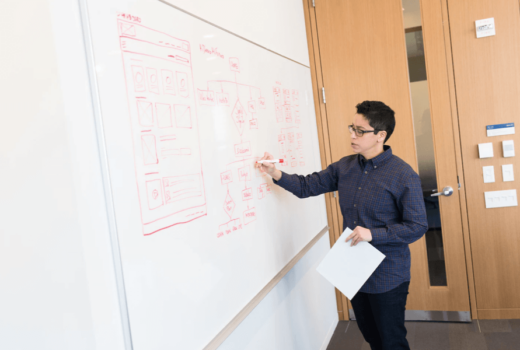Scheppers, niet consumenten

In een artikel over het veranderende onderwijslandschap en de consequenties daarvan voor een eigentijds, doeltreffend onderwijsbeleid, zegt Obama’s onderwijsbewindsman weer eens behartigenswaardige dingen. “Equity doesn’t mean that we give the same solution to every child.” En dat betekent dat scholen, docenten en beleidsmakers zullen moeten begrijpen wat ze doen, akls ze technologie inzetten in het onderwijs en leerprocessen. “The way we use and provide access to technology can either exacerbate or diminish the differences among young people from different communities.”
U leest het betoog van Duncan hieronder.
What Can Technology Do for Tomorrow’s Children?
Innovation in education goes well beyond gadgets and apps. Here’s my vision for the classroom of the future. School looks different today than it did even a handful of years ago. Teaching and learning is changing?—?in exciting ways?—?because the world is changing. We now live in a global economy with a knowledge-based marketplace, where the ultimate measure of our success is becoming less about what we know, but more about what we do with what we know, and learning new skills to fit a rapidly changing world.
Technology has helped to accelerate this pace of change, retooling nearly every aspect of our daily life, from how we communicate, to how we shop, to how we receive medical care. Schools?—?many of which have been slow to embrace innovation?—?are beginning to engage in this digital revolution.
However, technology can just as easily widen the lead for those who already have every advantage. If the technology revolution only happens for families that already have money and education, then it’s not really a revolution. In the United States, education is meant to be the great equalizer. Technology has the potential to bridge gaps for those who have the least. Simply put, technology can be a powerful tool for equality as well.
Classrooms across the country are marrying hands-on, inquiry-driven learning with digital technologies. They are blending traditional instruction with computer-based activities. They’re also using the web to provide teachers and students with greater access to resources, primary source documents, and faraway subject matter experts. Importantly, teachers are helping students to leverage technology as a platform for collaboration, creativity, and self-expression.
The $8 billion education technology sector has helped to make these changes possible, but we need to do even more. Innovation in education isn’t about the latest gadget or app, or about how adept a student is at using a smartphone to consume the latest Internet meme. It’s about how technological tools can empower students to become who they want to be, and who we need them to be?—?the kind of children and young people who ask, “What can I improve? How can I help? What can I build?”
It’s about teaching yourself new skills when you encounter new challenges. Efforts to further educational innovation must not only help students to develop skills for modern lives and careers. They also must help prepare students to be captains of their future and creators of a better world in ways in which my generation, likely yours, and others before us never dreamed possible.
Think about this: At Arizona State University’s Tempe campus, students in industrial design and innovation space programs use 3-D printers to solve real, human challenges, like designing products to assist people in wheelchairs with everyday tasks. And just a few decades ago, robots were the subjects of science fiction. Today, students like Kyle Weintraub are using robots to attend school while being treated for cancer.
Almost every aspect of what we find most familiar about education is getting recalibrated. Students are as likely to learn from one another as they are from their teacher. A final exam may be a design challenge with real world implications, not just a test for a grade. Today’s students are also much more likely to expect their school to adjust to their needs.
These are the right evolutions in our perceptions of teaching and learning. They’re also hard to do well, and widely. But, technology and innovation can help. Here’s what we need from technology in order for our children not only to flourish in?—?but also shape?—?the hyper-connected, high-tech world that awaits them:
We must make education technology more equitable.
One danger of educational technology is that digital-learning tools and innovation could miss their potential to close persistent opportunity gaps and instead disproportionately benefit students who already have the most advantages. The way we use and provide access to technology can either exacerbate or diminish the differences among young people from different communities.
That’s why the Obama administration has taken concrete steps to ensure access and equity in digital learning with funding for innovations that tailor learning to students’ needs and smarter assessments that measure content knowledge and important skills, like critical thinking.
Another positive step is the President’s major five-year challenge to give virtually all students in America access to next-generation broadband as part of ConnectED. Nearly 2,000 districts also have signed on to the Future Ready Pledge, committing to create a district-wide culture of using technology to tackle persistent challenges in education.
And in the field, there is a growing push to create open educational resources, available free of charge, to help bridge gaps in opportunity and resources. All students have a right to an education that helps them realize their greatest potential. This right should not be affected by geographic location, family income, disability, language, race, or background. Technology can help to expand opportunities for students that may not be available to them within the bounds of their physical classrooms.
But equity doesn’t mean that we give the same solution to every child.
Equity in education?—?and in educational technology?—?means that the tools and resources are personalized for each child’s needs. Great teachers have been doing this work for years. Technology can be a force-multiplier for teachers by helping them to see immediately which students need more support and then tailor learning activities accordingly.
Throughout all of this work, we must recognize that technology by itself is neither good nor bad; it is merely an accelerator. Our job?—?as educators, parents, policymakers, funders, and developers alike?—?is to ensure that we use technology to accelerate the right things. And one fail-safe measure of whether an innovation is worth accelerating is by determining whether it will help us create more opportunity for kids.
Teachers and students must be empowered as creators, not just consumers.
Until recently, the main function of public education has been to convey knowledge in one direction, from teachers to students. But with the growth of the Internet and mobile technology, our relationship to knowledge has fundamentally changed. To succeed in today’s world, our students need to be adept at not only recalling information, but using their knowledge to conceive, create, and employ solutions to real-world problems.
Students aren’t vessels to be filled with facts. And educators aren’t simply transmitters of information. Technology is enhancing the crucial relationship between educators and learners, helping teachers to use their time and talents more effectively to personalize learning for students?—?tailoring the pace, approach, and context of the learning experience to students’ individual needs and interests.
But teachers and students shouldn’t be limited as passive consumers of digital media. They can?—?and should?—?be the creators of information, best practices, and educational resources that can be shared with others across the country, and the world. Educators must be involved in the creation of these resources, at every step. It’s vitally important for the people who develop educational technologies to work side by side with our teachers, students, and families to help them unleash their own creativity and solve issues that matter most to them.
That’s why I am encouraged by the first-ever Ed Tech Developer’s Guide recently released from the U.S. Department of Education. It’s intended to be a handbook for entrepreneurs, nonprofits, and others who want to design tools that make a difference in our schools. The central promise of personalized learning is to help people develop their unique strengths and passions. Both teachers and students can benefit from a vision of personalized learning that helps them become smart consumers and skilled creators of content and tools.
We must make teaching more sustainable.
Educators frequently share that teaching is the most difficult job anyone can have?—?and also the most rewarding. Teachers can literally shape the way young people see themselves and the world. Unfortunately, their efforts are too often not fully appreciated, supported, or immediately rewarded.
The implications of that statement are clear: If we want to make teaching a more desirable?—?and sustainable?—?profession, we need innovative approaches that amplify the rewards and diminish the difficulties of being an educator.
Technology can help by ensuring that professional development for teachers is just as personalized and meaningful as the education we expect them to provide to their students. We also need tools and platforms that provide customized feedback to teachers so they can deepen the quality of their practice precisely in the ways?—?and at precisely the times?—?they need. We need tools that ease the administrative burdens of the job to free teachers to spend more time engaging with their students.
At the Department of Education, we’re working to do our part, whether it’s investing in promising innovations in teaching and learning, or helping to create the conditions for teachers to amplify their voices and lead from the classroom. The Race to the Top-District program has helped urban and rural areas alike to create new district-level roles that bridge curriculum and technology as well as teacher-leadership roles within schools, like master educators, individualized learning specialists, and technology coaches.
Everyone has an essential role to play in elevating and supporting the teaching profession. Teachers must be willing to explore new ways of supporting and challenging themselves and their students. Students must assume more responsibility for their own learning. Principals must create school climates that honor innovation and experimentation. Elected officials and policymakers must be willing to incentivize policies and programs that lift up the profession?—?through more resources, support, and funding.
Collectively, we must be willing to let go of a lot of the things we’ve been associating with schools for a long, long time. The world is changing?—?and our schools must prepare students to become the people who will shape it for the better.”
Meest Gelezen
‘Free riding brengt het hoger onderwijs in de problemen’
Vrouwen houden universiteit draaiende, maar krijgen daarvoor geen waardering
Hbo-docent wil wel rolmodel zijn, maar niet eigen moreel kompas opdringen
‘Sluijsmans et al. slaan de plank volledig mis’
Aangepast wetsvoorstel internationalisering dient vooral samenleving in plaats van student



